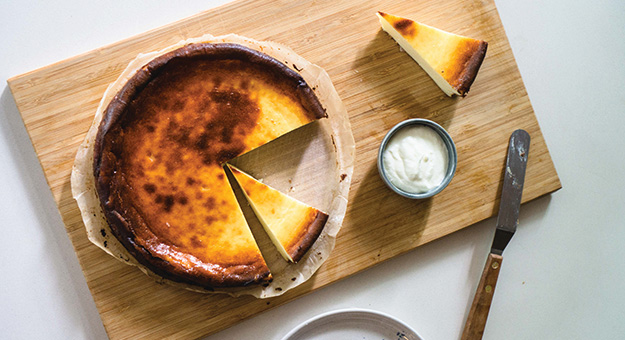In the latest chapter of the Malaysian cheesecake craze, we’ve fallen head over heels for arguably the best cheesecake yet—The Tokyo Restaurant’s 6th Avenue cheesecake. This cheesecake has become the darling of the Malaysian dessert scene, dominating the top of many cheesecake listicles and garnering endless rave reviews. And though the restaurant does its best to entice us all with its sushi rolls and yoshoku-inspired food, we all know that 9 out of 10 times, we’re there for the cheesecake.
Is it really worth all the hype? If you’re anything like me and have a proclivity for the richer things in life, it’s hard not to be smitten by it. However, despite the setting in which it is served – at The Tokyo Restaurant at Isetan the Japan Store – this isn’t your typical Japanese cheesecake. After all, Japanese cheesecakes largely refer to those light and cottony cheese-flavoured sponge cakes made with a base of whipped egg whites, more similar in texture to chiffon cakes than, say, the archetypal Oreo or New York cheesecakes.
The 6th Avenue cheesecake, on the other hand, takes inspiration from the burnt cheesecake famous in the Basque Country of Spain. It features a beautifully brûléed top, courtesy of the extreme oven heat which caramelises the crust of the cake. Compared to Japanese cheesecakes, it is a lot more compact and is thus a whole lot richer and gloriously cheesier too. The real kicker though is its texture. Whenever I’ve ordered it, I tend to savour it from the outside in, going from a lingering, tongue-coating smoothness with bits of burnt crust, to a supple, jelly-like centre that just barely holds together, its velvety smoothness reminiscent of the most decadent custard or crème mousseline.
This cheesecake is served with barely any garnish – just a confident slice of the cake itself, with an almost nonchalant dollop of cream. The cream, it seems, serves to cut through the richness of the cake more than anything else. Well, that is, if, for whatever absurd reason, you grow tired or feel too jelak from eating just cake.
Now I know me talking about cheesecakes isn’t doing much to help satisfy your cravings. But guess what, just shy of giving away free cake, I’ve got a real treat for you! After weeks of extensive tests and baking more cheesecake than I can stomach, I think I might’ve just cracked the cheesecake code, and I now have a working recipe for this very cheesecake, which I think comes pretty close to the original.
The key here, I found, is in the baking time. Traditional cheesecakes call for the cake to be cooked through completely. But to get that custard-like centre of The Tokyo Restaurant’s cheesecake, it’s crucial to halt the cooking when the middle is still deceptively wobbly, letting the residual heat from the sides of the cake cook through to the centre, taking it just to the edge of doneness. Oh, and one other thing – compared to most cheesecakes, the pre-baked batter of this cheesecake has considerably more liquid in it (thanks to the extra eggs and cream), which again helps to form that custardy soft texture. Now brace yourself for a cheesy coma post-baking.
Recipe: Not Quite The Tokyo Restaurant Cheesecake
Makes one 9-inch cake; Serves 6-10

Ingredients:
600g cream cheese 200g caster sugar 5 (~250g) medium eggs 280ml cream 25g all-purpose flour 1 tablespoon (15ml) lemon juice ½ teaspoon (3g) salt
Directions:
1. Before you begin, make sure you take the cream cheese and eggs out of your refrigerator an hour before you use them to get them to room temperature.
2. Line the bottom of your cake tin with parchment paper (8 to 10-inch springform cake tins work best), and grease the bottom and sides so that the cake won’t stick after baking.
3. Preheat your oven to 200°C (for fan-assisted; 210°C for static heat).
4. In a stand mixer with the paddle attachment, beat the cream cheese and sugar on medium speed for about 5 minutes until smooth. Then, turn the mixer to low and add the eggs one at a time, making sure to scrape down the sides of the mixer bowl so everything is incorporated. Add the cream, all-purpose flour, lemon juice and salt, and mix through on low until everything is well incorporated. If your mixture has tiny lumps in it, you can pass it through a sieve/chinois. (Though if you can’t be bothered, you can rest easy because it won’t affect the final product too much).
5. Pour the cheesecake batter into your greased cake tin, and bake it immediately in the oven for 20-30 minutes. At the 15-minute mark, rotate the cheesecake to help it cook evenly. After 20 minutes of baking, test the doneness of the cheesecake by giving the cake tin a gentle shake. The middle should wobble slightly like a firm jello/agar-agar, but not too much. (Stick a cake tester about an inch off the centre if you’re unsure. If it comes out clean, the cheesecake is done! The centre might still be a tad underdone but that’s what we want!)
6. Remove the cake from the oven and let it cool completely on a cooling rack before removing it from the tin.
7. Now this is the hardest step – resist the temptation of digging straight into it, as it tastes even better after being chilled in the refrigerator for an hour or two. When you’re ready to eat, slice it up and serve with a dollop of cream.
Follow Jun on his blog – junandtonic.com for more recipes and musings on food.
| SHARE THE STORY | |
| Explore More |



